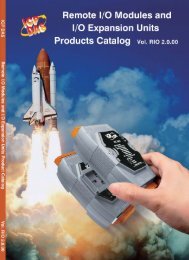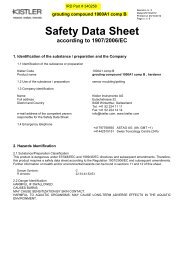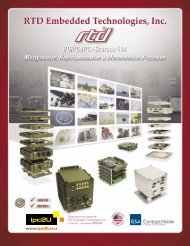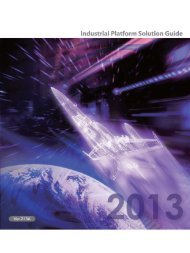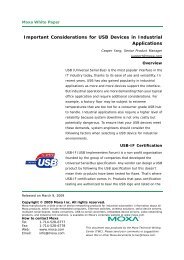How to Build Industrial Computers that Resist Vibration and Shock
How to Build Industrial Computers that Resist Vibration and Shock
How to Build Industrial Computers that Resist Vibration and Shock
You also want an ePaper? Increase the reach of your titles
YUMPU automatically turns print PDFs into web optimized ePapers that Google loves.
WHITE PAPER<strong>How</strong> <strong>to</strong> <strong>Build</strong> <strong>Industrial</strong><strong>Computers</strong> <strong>that</strong> <strong>Resist</strong><strong>Vibration</strong> <strong>and</strong> <strong>Shock</strong>Bruce ChenProject SupervisorMoxa Inc.
WHITE PAPER<strong>Vibration</strong> <strong>and</strong> <strong>Shock</strong><strong>Industrial</strong> computersneed <strong>to</strong> be designed <strong>to</strong>withst<strong>and</strong> vibration <strong>and</strong>shock, which are a fac<strong>to</strong>f life in many industrialapplications.Systems should avoidresonance, which allowseven small forces <strong>to</strong>create extreme vibration<strong>and</strong> shock.<strong>Industrial</strong> computer manufacturers need <strong>to</strong> deliver a product <strong>that</strong>is rugged, hardened, <strong>and</strong> reliable <strong>to</strong> a degree beyond the consumerst<strong>and</strong>ard. These requirements exist because industrial computersare often deployed in severe conditions <strong>and</strong> harsh environments,sometimes even on moving vehicles. One key industrialrequirement is vibration <strong>and</strong> shock resistance, which allowsindustrial computers <strong>to</strong> operate in truly extreme conditions.There are some industrial applications, such as rolling s<strong>to</strong>ck, wherevibration <strong>and</strong> shock are the most significant fac<strong>to</strong>r affecting thestability <strong>and</strong> reliability of system operations. <strong>Computers</strong> in rollings<strong>to</strong>ck applications are deployed on moving objects <strong>that</strong> rattle <strong>and</strong>shake, so anti-vibration <strong>and</strong> anti-shock technology is a centralrequirement. Certain rolling s<strong>to</strong>ck applications, such as NetworkVideo Recording (NVR) systems, specifically need high s<strong>to</strong>ragecapacity <strong>to</strong> record <strong>and</strong> s<strong>to</strong>re surveillance video images. Hard diskswould be the most reasonable <strong>and</strong> cost-effective way <strong>to</strong> s<strong>to</strong>re all ofthis data, but deploying hard disks in a high-vibration high-shockenvironment, such as on a bus, train, or truck, is a significantchallenge.This white paper first explains some background about the physicsbehind vibration <strong>and</strong> shock, <strong>and</strong> then explores the specificmechanisms <strong>and</strong> technology used <strong>to</strong> build an industrial computerwith high resilience against vibration <strong>and</strong> shock.About <strong>Vibration</strong>Physically, there are two kinds of vibrations: free vibration <strong>and</strong>forced vibration. Free vibration occurs when a mechanical systemis acted on by an initial input <strong>and</strong> then allowed <strong>to</strong> vibrate freely.Forced vibration occurs when an oscillating force or motion isapplied <strong>to</strong> a mechanical system.About ResonanceIn physics, “resonance” describes how a system can oscillate atlarge amplitudes at specific, "resonant" frequencies. An importantpoint <strong>that</strong> all engineers must keep in mind is <strong>that</strong> a low amplitudeforce acting at the system's resonant frequency can createextremely large displacements.Resonance occurs in systems <strong>that</strong> can convert back <strong>and</strong> forthbetween s<strong>to</strong>red (or potential) energy <strong>and</strong> kinetic energy. Theclassic example of a resonant system is a pendulum, whichalternates between states of high-kinetic <strong>and</strong> low-potential energy(when the pendulum moves through the vertical position at thebot<strong>to</strong>m of its swing) <strong>and</strong> low-kinetic <strong>and</strong> high-potential energy(when the pendulum slows down <strong>and</strong> then reverses direction). Thependulum will swing at its resonant frequency if the only externalforce is gravity. Although a simple pendulum has only oneReleased on Oc<strong>to</strong>ber 1, 2010Copyright © 2010 Moxa Inc., all rights reserved.Moxa manufactures one of the world’s leading br<strong>and</strong>s of device networking solutions. Products include industrialembedded computers, industrial Ethernet switches, serial device servers, multiport serial boards, embedded deviceservers, <strong>and</strong> remote I/O solutions. Our products are key components of many networking applications, includingindustrial au<strong>to</strong>mation, manufacturing, POS, <strong>and</strong> medical treatment facilities.<strong>How</strong> <strong>to</strong> contact MoxaTel: 1-714-528-6777Fax: 1-714-528-6778Web: www.moxa.comEmail: info@moxa.comThis document was produced by the Moxa Technical WritingCenter (TWC). Please send your comments or suggestions aboutthis or other Moxa documents <strong>to</strong> twc@moxa.com.Copyright © 2010 Moxa Inc.1
WHITE PAPER<strong>Vibration</strong> <strong>and</strong> <strong>Shock</strong>resonant frequency, more complex systems can have two or moreresonant frequencies.Resonance occurs when the frequency of the forcing function matches the natural frequency ofthe systemFailure TheoryOnce we underst<strong>and</strong> how resonance is created, we can work <strong>to</strong>reduce it by adopting special designs <strong>and</strong> technology. One way <strong>to</strong>do this is by applying failure theory <strong>to</strong> predict the vulnerabilities ofan industrial system, <strong>and</strong> then use these results <strong>to</strong> designindustrial computers <strong>that</strong> are highly resilient against vibration <strong>and</strong>shock. Two specific concepts in physics are highly pertinent when itcomes <strong>to</strong> vibration <strong>and</strong> shock:Leverage: The most stable point of a see-saw is the pivot point.Engineers can use a similar principle when deciding where <strong>to</strong> placevulnerable system components, such as the hard drive. Becausethe fulcrum of the system board remains stable, componentsplaced there will experience less vibration <strong>and</strong> shock no matterhow much the board shakes.The pivot points on a system will experience the least vibration <strong>and</strong> shockCopyright © 2010 Moxa Inc.2
WHITE PAPER<strong>Vibration</strong> <strong>and</strong> <strong>Shock</strong>Asymmetrical Balance: Most computers are fairly symmetrical,simply because symmetrical systems are easier for engineers <strong>to</strong>design <strong>and</strong> develop. <strong>How</strong>ever, symmetrical systems also tend <strong>to</strong> bemore resonant in severe conditions, <strong>and</strong> particularly in movingvehicles. An asymmetrical design is an effective way <strong>to</strong> reducesystem resonance <strong>and</strong> minimize vibrations <strong>and</strong> shock. A system<strong>that</strong> is asymmetrically balanced can disrupt energy wavetransmissions <strong>and</strong> reduce vibrations. This concept can be applied<strong>to</strong> off-the-shelf hard disks <strong>to</strong> create a cost-effective yet reliables<strong>to</strong>rage solution for moving vehicles.Asymmetry helps fragile components, such as hard disks, avoid resonanceSystem-wide Design PerspectiveAn effective industrial computing system needs <strong>to</strong> approach antivibration<strong>and</strong> anti-shock from a comprehensive system-wideperspective. A thorough underst<strong>and</strong>ing of the narrow componentperspective is important, but it is also important <strong>to</strong> underst<strong>and</strong>how each component fits <strong>to</strong>gether in<strong>to</strong> the big picture of a broaderanti-vibration <strong>and</strong> anti-shock technology. This means <strong>that</strong>hardware, thermal design, <strong>and</strong> component engineers need <strong>to</strong>collaborate <strong>to</strong> create the optimal, integrated system solution.Mortise <strong>and</strong> Tenon JointsThe constant movement of high vibration environments causesconstant stress on the mechanical joints in a device. Rigid screws,joints, <strong>and</strong> bindings perform poorly in these environments. Incontrast, a mortise <strong>and</strong> tenon joint is simple, strong, <strong>and</strong> flexible.Tenon joints are a unique strategy <strong>that</strong> bes<strong>to</strong>w greater vibration<strong>and</strong> shock resilience on computing systems.A mortise <strong>and</strong> tenon joint is a simple, strong, <strong>and</strong> flexible way <strong>to</strong> create a mechanical jointCopyright © 2010 Moxa Inc.3
WHITE PAPER<strong>Vibration</strong> <strong>and</strong> <strong>Shock</strong>Material SelectionAluminum Alloy: When it comes <strong>to</strong> exterior casing, aluminumalloy is a superior material compared <strong>to</strong> sheet metal, because it ismore rugged, stronger, <strong>and</strong> can endure more vibration <strong>and</strong> shock.Aluminum alloy is light, easy <strong>to</strong> shape, <strong>and</strong> also has high heatconductivity, all of which provides a reliable operating platform forthe entire system.Aluminum is a rugged alloy highly resistant <strong>to</strong> vibration <strong>and</strong> shockDamping Material: Damping material is used <strong>to</strong> reduce theimpact of vibration <strong>and</strong> shock. As part of an overall anti-vibrationstrategy, it is particularly useful as a <strong>to</strong>ol <strong>to</strong> fine-tune thecharacteristics of the anti-vibration <strong>and</strong> anti-shock design.Damping material placed at just a few key locations can substantially improve the overallsystem’s vibration <strong>and</strong> shock resistance.Copyright © 2010 Moxa Inc.4
WHITE PAPER<strong>Vibration</strong> <strong>and</strong> <strong>Shock</strong>Component SelectionTraditional computers usually use st<strong>and</strong>ard DIN 41612 connec<strong>to</strong>rs<strong>to</strong> connect the computer <strong>and</strong> its modules. <strong>How</strong>ever, the compactPCI connec<strong>to</strong>r is a better solution for industrial computers as ittransmits signals more efficiently <strong>and</strong> can resist more vibration <strong>and</strong>shock impact.EN 50155 CertificationEN 50155 certification is the European st<strong>and</strong>ard <strong>that</strong> covers allelectronic devices used in rolling s<strong>to</strong>ck applications, <strong>and</strong> isparticularly pertinent <strong>to</strong> railway applications. Rolling s<strong>to</strong>ckindustrial computers must comply with the following st<strong>and</strong>ards forvibration <strong>and</strong> shock:<strong>Vibration</strong> (operational): 5 <strong>to</strong> 150Hz 10mins/Axis[Acceleration: 1.0 m/s 2 rms (Longitudinal/Transverse/Vertical)]<strong>Vibration</strong> (non operational): 5 <strong>to</strong> 150Hz 5hrs /Axis[Acceleration: 7.9 m/s 2 rms (Longitudinal/Transverse/Vertical)]<strong>Shock</strong>: Half Sine Wave 50m/s 2 30 ms (Longitudinal/Transverse/Vertical)The EN 50155 st<strong>and</strong>ard is a helpful benchmark for engineers whoare building computers used for rolling s<strong>to</strong>ck applicationsConclusionTo be rugged <strong>and</strong> reliable enough for rolling s<strong>to</strong>ck applications,industrial computers need <strong>to</strong> be designed <strong>to</strong> resist vibration <strong>and</strong>shock. The strategies outlined above demonstrate <strong>that</strong> it ispossible <strong>to</strong> build a system <strong>that</strong> is highly resistant <strong>to</strong> vibration <strong>and</strong>shock while still delivering excellent performance, features, <strong>and</strong>cost-effectiveness.To keep pace with the latest anti-vibration <strong>and</strong> anti-shockinnovations, as well as other developments in railway computingtechnology, subscribe <strong>to</strong> Moxa’s Railway Intelligence Newsletter atwww.moxa.com/Event/Group/2010/railway_newsltr/Index.html.DisclaimerThis document is provided for information purposes only, <strong>and</strong> the contents hereof are subject <strong>to</strong> change withoutnotice. This document is not warranted <strong>to</strong> be error-free, nor subject <strong>to</strong> any other warranties or conditions, whetherexpressed orally or implied by law, including implied warranties <strong>and</strong> conditions of merchantability, or fitness for aparticular purpose. We specifically disclaim any liability with respect <strong>to</strong> this document <strong>and</strong> no contractual obligationsare formed either directly or indirectly by this document.Copyright © 2010 Moxa Inc.5



